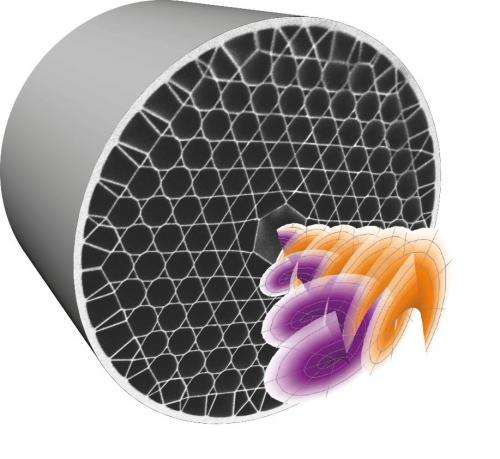June 30, 2011 feature
Transporting spatially entangled photons through an optical fiber

(PhysOrg.com) -- "Spatially entangled photons is a hot topic in quantum information science, and optical fibers are the cornerstone of our communication society," Wolfgang Loffler tells PhysOrg.com. "So far, though, no one that we know of has demonstrated that you can use a fiber to transport a photon entangled in its spatial degree of freedom."
Löffler is a scientist at Leiden University in The Netherlands. Löffler worked with E.R. Eliel and J.P Woerdman at Leiden, as well as T.G. Euser, M. Scharrer and P. St. J. Russell at the Max Planck Institute for the Science of Light in Erlangen, Germany, to demonstrate that a spatially entangled photon can successfully travel through an optic fiber. The team presents its findings in Physical Review Letters: “Fiber Transport of Spatially Entangled Photons.”
Right now, many photons are entangled using only their polarization degree of freedom. This limits the amount of information that can be encoded, and also limits the amount of entanglement possible per photon. However, by using the spatial degree of freedom, there are many more options for information encoding. “Polarization-based entanglement is strictly two-dimensional,” Löffler explains. “When you deal with spatially quantum-entangled photons, you have entanglement in higher dimensions, and you can encode more data.” He also points out that, “The spatial structure of a single photon field has basically infinite dimensions.”
Such high-dimensional entanglement could lead to better security in quantum cryptography, among other applications. “More quantum entanglement per photon can be used to enhance security or increase the resilience against noise,” says Löffler. “The prospects are great.”
However, not just any optical fiber will do; in most conventional fibers, the spatial information is quickly lost, and only the spectral or temporal information is preserved. In order to take advantage of the ability to encode information in spatial degree of freedom, a special fiber is needed. “Working with Russell, who is a pioneer in photonic crystal fibers, we were able to find a suitable multimode fiber.”
Löffler says that this special fiber is constructed in such a way that light can be guided, mainly through air, in a hollow core. “This has a less detrimental effect on the photons that we want to get through the fiber,” he says. Löffler and his colleagues tested the multi-mode fiber, and were able to get a positive result in a rudimentary quantum cryptography setup.
Even with the positive result, Löffler cautions that there are still some issues that need to be resolved. “We need to figure out how to extend this scheme to longer distances, so we will need to study the fiber transport mechanisms closer to understand them better.” He also points out that the team was able to demonstrate transport of 3D entangled photons through the fiber, and the next step is to add more dimensions.
It is also important to remember that the team has tested only a limited number of fibers. “We have excluded many different fiber types, and we have found this one that works so far,” Löffler says. “There are additional fiber structures to test before we can say which would truly work best for transport of the spatially entangled photons.”
Although there is still work to do, Löffler is optimistic about the future. “We showed that you can combine spatial entanglement with optical fiber transport, and that is promising for what could be next.”
More information: W. Löffler, T.G. Eliel, M. Scharrer, P. St. J. Russell, and J.P. Woerdman, “Fiber Transport of Spatially Entangled Photons,” Physical Review Letters (2011). Available online: link.aps.org/doi/10.1103/PhysRevLett.106.240505
Copyright 2011 PhysOrg.com.
All rights reserved. This material may not be published, broadcast, rewritten or redistributed in whole or part without the express written permission of PhysOrg.com.




















